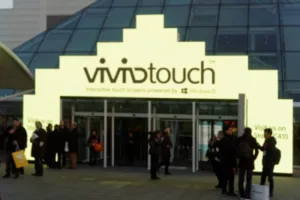It was hard to miss the big LED sign for “VividTouch” that was around the entrance to BETT. The first surprise came, really, when we got to the booth and found it populated by staff from UK educational technology distributor, Steljes. Steljes, as some of you will know, has been the pioneer of IWBs and flat panels into the UK market and has been for nearly 20 years, the exclusive distributor for Smart Technologies.
VividTouch is a new brand, owned by Steljes, that was launching its interactive displays at the show, with more surprises. First, the systems are built on Windows 10 and that makes them very unusual, as almost everyone else is building around Android. We saw the systems in action and it certainly looked like Windows 10 to us, although Steljes has added some extra buttons to the front panel to allow hardware input selection, screen blanking and “freezing” and other features that are useful in the classroom. There are connections on the front to access the internal USB and also to connect external BYOD devices.
Another surprise was the selection of the touch technology. At the show, virtually all of the touch was based on infrared, with a handful of displays offered with procap touch. Steljes has gone a different way, and has adopted the FlatFrog acoustic technology that we have been reporting on for some time (You can see a video from ISE last year here – FlatFrog Extends its Optical Touch Technology). A significant reason is that the system is very accurate and can distinguish between hands and passive pens. It is also insensitive to ambient light and other infrared sources. Steljes is sourcing the systems in Taiwan, but told us that it has an exclusive design. (We have previously reported that FlatFrog has done a deal with Wistron, so that may be the source for this product – Man. Ed.)
The systems will initially be offered in 65″ (FullHD at £2,849 and UHD at £3,499) and 84″ UltraHD at £5,499. A 75″ set will be available in April with pricing between the 65″ and 84″.
Analyst Comment
From the product point of view, these look like interesting systems. Running Windows 10 makes teachers very comfortable, as they know their way around the Microsoft offer and the cloud support in Windows 10 is pretty good – enabling access to OneDrive, OneNote etc. Standing out from the Android crowd is also a big advantage. There are lots of apps available from the Windows store and that is another advantage.
The main potential disadvantage of the configuration is that it will have only limited opportunities for upgrades. In four or five years, the current Windows 10 may seem very dated (although Microsoft has said that it will work on incremental upgrades now, rather than any major new version of Windows, so at least attention won’t be drawn to other updates, as it has been in the past.
On the commercial side, this launch effectively means that the Smart deal will come to an end, although untangling it may be interesting as Steljes has invested a lot of time and money in supporting Smart – a not inconsiderable load that Smart or any new distributor will have to pick up. (BR)

